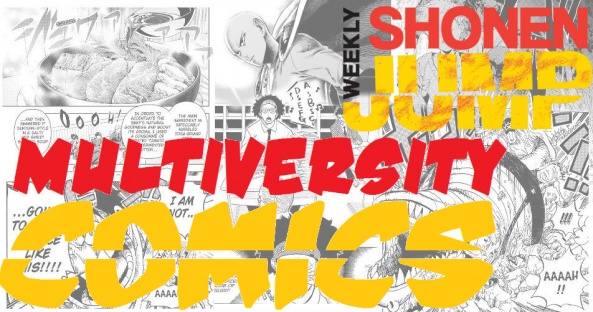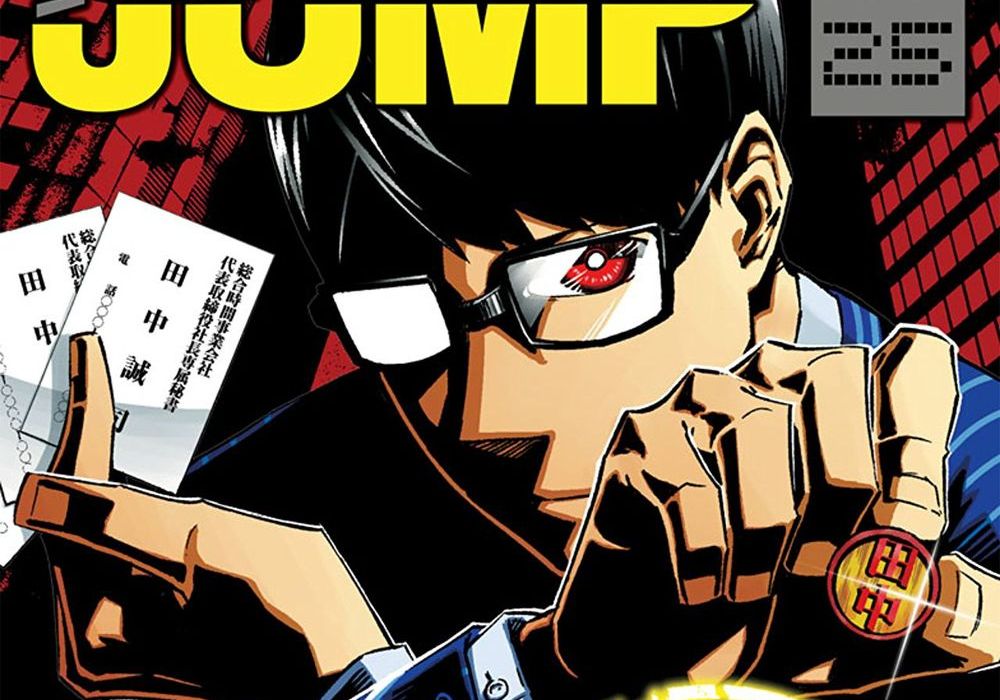
Welcome to This Week in Shonen Jump, in which a rotating duo of Multiversity staffers take a look at two stories contained in each installment of Viz Media’s Weekly Shonen Jump. For the uninitiated, Weekly Shonen Jump is an anthology that delivers more than 200 pages of manga of all varieties. We hope that you’ll join us in exploring the world of Weekly Shonen Jump each week. If you are unfamiliar, you can read sample chapters and subscribe at Viz.com.

This week, Zach and Vince check in with “Seiji Tanaka” and “Dr. Stone.” If you have any thoughts on these titles, or “My Hero Academia,” “We Never Learn,” “The Promised Neverland,” “Robot X Laserbeam,” “Black Clover,” “Food Wars,” or “Yu-Gi-Oh Arc V,” let us know in the comments!

Seiji Tanaka Chapter #1
Written and illustrated Keiji Amatsuka
Reviewed by Zach Wilkerson
It’s difficult for a new series to find a strong hook inn the fast paced world of weekly shonen manga. However the latest series, the verbosely titled “Seiji Tanaka: Secretary to the Managing President, General Time Industries,” mixes popular slacker tropes with time traveling assassins to deliver one of the best Jump Starts in recent memory.
Nagato Tokioka is your typical underachiever, more concerned with getting video game high scores than giving a second thought about the future. So, when the future comes to him, in the form of his one-day secretary, it’s definitely a bit of a shake up. Not only does Nagato learn that he’s the inventor of time travel and eventual president of a multi-trillion dollar company, but that his future business rivals are gunning for him in the present. The “Terminator”-esque plot benefits from a number of flourishes, such as subway cars as the time-travelling vehicle of choice. However, the strongest hook is the titular secretary; Seiji Tanaka.
Seiji takes his secretarial duties to the nth degree, doubling as bodyguard for the hapless Nagato. Equipped with weaponized business cards, stamps, and ink pens, Seiji takes out would be future attackers with impeccable style and manners. He plays into tropes of rigid Japanese salarymen and shonen power fantasies alike. The result is surprisingly thrilling.
While Nagato takes a clear backseat in this debut chapter, he is endearing in his own way. Despite his relative ineptitude, the focus on his willing to help his friends advance and succeed betrays his seemingly selfish persona. The setup for his ascent to time-manipulating business mogul contributes to the strong opening.
Artistically, Amatsuka’s pencils are rough and lacking the finesse of fellow WSJ illustrators. However, the highly energetic style meshes well with the quirky and comedic quality of the story, making for a satisfying product overall. Amatsuka’s high for action and framing is spot on, delivering a number of memorable scenes and panels.
Overall, “Seiji Tanaka” is an excellent start for this new series. Recent batches of Jump Starts have had little luck gaining traction with a western audience, leaving a dearth of fresh titles in the American version of the magazine. This is one series I look forward to reading over the next couple of weeks, and hopefully for months to come.
Final Verdict: 8.3 – A fun high concept and quirky takes on shonen tropes make this a must read Jump Start series.

Dr. Stone, Chapter 62
Written by Riichiro Inagaki
Illustrated by Boichi
Review by Vince J Ostrowski
I’ve dipped in and out of “Dr. Stone” with a great deal of interest and hope that what started out as a crackerjack premise would evolve into another manga where the central conceit come together with great characters that deepen and evolve over time. Having recently hopped back in, what I found was a book that is no better or worse than it was from the very beginning, which is overall a good thing with one disappointing caveat. “Chapter 62” presents a simple conflict: the “heroes” of “Dr. Stone” want to rebuild the world (it having turned entirely into stone in the series’s opening chapter) and an intimidating band of rogues (led by the enigmatic Tsukasa) want to stymie that in favor of their getting to rule the entire world themselves. We find our heroes split into two groups: one ahead of a scout/spy from Tsukasa’s gang who is giving them chase and another who is lagging behind chasing the scout.
Continued below“Dr. Stone’s” most superlative element is its interest in delivering scientific “lessons” to the reader in a clean and practical fashion as the characters in the story work to solve a problem or gain the upper hand. These scientific methods take the place of, but have the same effect as, a typical Shonen character in a different kind of manga announcing their elaborate fighting move or superpower. Boichi’s art always deliver these in a clean and clear fashion – you probably can’t easily do the experiments in your own home – but scientifically, they make sense and they’re always clearly applied to the story. In this chapter, one team uses some iridescent trickery to track the scout, while the other group MacGuyver’s their way into the first cellular phone in the post-apocalyptic landscape. The way that these two ideas are applied to the chase are amazingly intuitive. You never get the sense that Inagaki-san is ever “stuck” trying to write his way out of a situation using a cop-out or a Deus Ex Machina – every story beat perfectly flows from one to the next, every step of the heroes’ plan makes reasonable enough sense, and uses exactly what we see laid out before them.
But while the storytelling flows well and the application of scientific concepts is genius in execution, the characters of “Dr. Stone” continue to elude me a little: something that has not changed about the book since it’s early chapters. Senku, the brainier of the central characters, is pretty well-defined. He’s cocksure and puts himself in charge at all times, thanks to his intellect, but he’s loyal and genuinely wants what’s best for everyone in the group (or really, the world). Beyond Senku, I struggle to come up with anything but the most superficial description of anyone else. The hook of “Dr. Stone” is the strength of the plot, which never loses sight of what immediate end goal the book has set up for itself, but it just doesn’t have those characters that you hook into, get to know, and really end up loving. I think there have been attempts throughout past chapters or arcs to establish the characters a little more, but on a week to week basis very little seems to be sticking. They don’t carry the book – the book really carries them, which is fine because the plot happens to be really compelling with those science bits peppered in. Boichi is a terrific artist, but again Senku is really the one character that makes a majorly distinct visual impression. The magic of the art is really in the way he depicts the problem-solving and the chase, not that characters. Again, it still makes “Dr. Stone” a legitimately thrilling read.
Final Verdict: 7.5 – “Chapter 62” is a very good place for a potential new reader to start, telling a story that almost has its own “arc” from beginning to end, but setting you up for a potential confrontation in the next chapter. The characters may not be as memorable or charming as other Shonen Jump entries, but the plot and the pacing is second to none.






